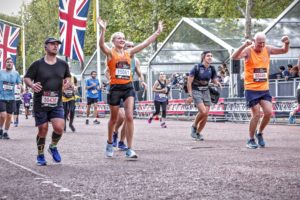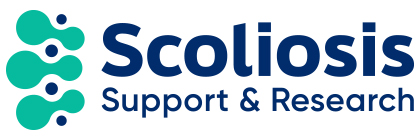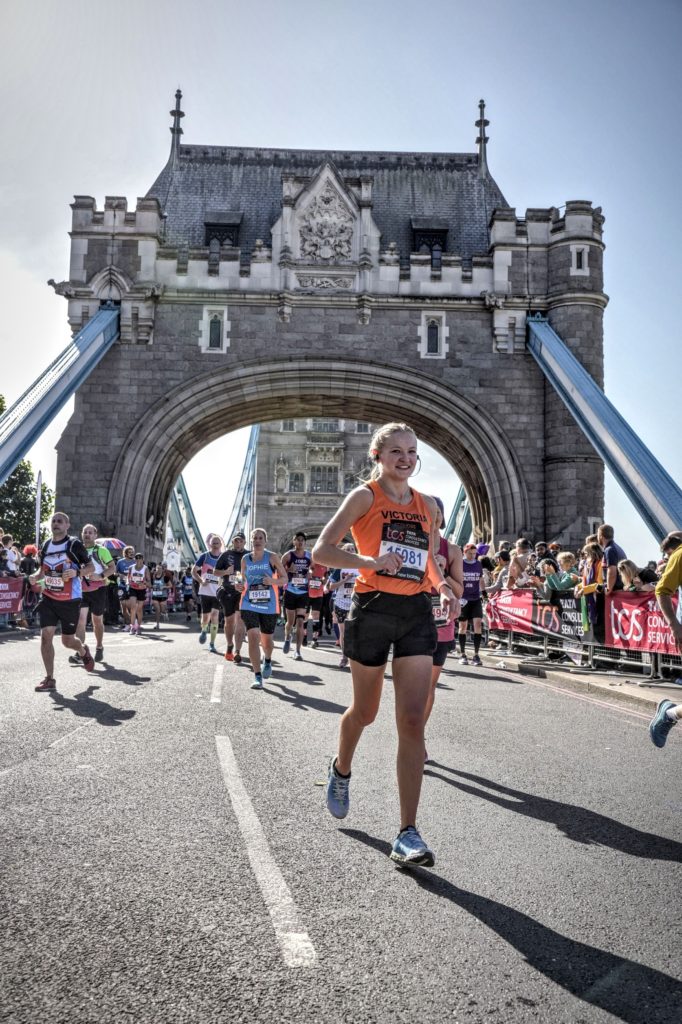Monday – Friday 9am to 5pm
Victoria Steele – London Marathon experience
Running a marathon has been on my bucket list for a long time, despite my hatred of Cross Country at school, which I did for 8 years!
I was diagnosed with scoliosis in 2013 and had surgery in December of that year, fusing my spine from T2-L3, at the age of 17. At the time, I loved to dance, and was attending dance classes 4 times a week. I was lucky enough to return to dance 3 months post-op, performing at Disneyland, Sadlers Wells, and gaining 94% in my dance exams 6 months after surgery. Being active post-op was important to me; I returned to the gym, started running again, went skiing, continued dancing, and took up cheerleading at university.
In my first year at university, I decided to apply to run the London Marathon for SAUK, however at the time, I was not running regularly, I tried to increase my mileage too quickly and ended up with shin splints (nothing to do with my back) but sadly had to drop out. This experience was tough, and honestly embarrassing, to not be able to complete something I wanted to. Running took a back seat in my life, and I continued instead with dance and cheerleading, occasionally running a few miles on the treadmill. In 2018, I had a second surgery removing three screws from the top right side of my spine following pain. This surgery was a success and recovery was so much quicker.
During lockdown, like a lot of people, I took up running to get out the house, keep fit and stay sane whilst working as a mental health practitioner. This time, I removed the pressure I put on myself, stopped thinking about my time and distance, and used it to look after myself and my mental health. I slowly increased my mileage, running an extra mile every week, and eventually found myself running a half-marathon! Once I’d done this, I knew I wanted to run an organised half-marathon. I moved to London and found running an amazing way to see the sights of my new area, running along the Thames and into the city, I also joined a running club and found it an ideal way of meeting new people. I ran the Richmond half-marathon in 2021, and was incredibly proud of my time, but also for completing it. At the time, I was struggling with pain in my back. I have often suffered with screws rubbing in my back and sitting quite close to the surface of the skin, causing pain. This is nothing to do with running, and I often found that running helped to ease the pain and helped me with the frustration of being in pain; getting out the house and moving always helps me to feel better. Even if it’s just a short walk. On days when I don’t want to run, I know that if I can get through the first 5 minutes, it gets so much better and easier.
Following the half marathon, I knew I was in a much better position to be able to train for the marathon. I had increased my mileage gradually; my shins were no longer causing pain and I knew I was at an ideal time of my life to train. I contacted SAUK and was lucky enough to get a place on their team.
Training for a marathon is tough! I did a lot of running over the summer, though arguably nicer than dark winters, it was an incredibly hot summer. Early starts on the weekend to get 15 plus miles in was hard, especially after going out the night before, as well as dragging myself out after long days at work. Running for 3 plus hours can be lonely and mentally challenging but I found podcasts really helped me and kept me motivated to keep going. Living in London also meant I have some amazing running routes. I loved running into the city centre, seeing the sights, running up the Mall and over Tower Bridge, round the Tower of London and through Hyde Park on many occasions. I hate to be one of those people, but I also enjoyed running on holiday, I ran in gyms whilst holidaying in America, and an early morning run in extreme humidity with my brother in New Orleans was also an experience!
I think the experience of surgery makes us so much more resilient to things, when runs were hard, I knew I could get through it because I’d got through surgery. I also found myself thinking about 16-year-old me, being diagnosed with scoliosis, being unsure what life would look like and scared, and hopefully I’ve made her proud!
October 2nd ,2022 was a day I will never forget. Though nerve-racking standing at the start line knowing I had 26.2 miles ahead of me, I loved it. Lots of people have asked whether I ran alone, and I did. It would have been fun to do it with a friend or family member, but I think it made it more special that it was an experience and challenge that I did alone. I was able to see my family and friends’ multiple times along the route, as well as taking in the shouts and cheers of so many amazing supporters. Everyone says you hit the wall around mile 20, knowing you have 6 miles left and probably at least an hour of running to go. It was mentally difficult but there was so many people watching, I couldn’t stop. Miles 22 to 24 were probably the hardest of me, but I kept putting one foot in front of the other, had some good music and the thought of a glass of champagne and a burger at the end kept me moving. The last 2.2 miles were amazing, the crowds and atmosphere, with the sights of London and knowing I had nearly completed it. I even had what felt like a sprint in me, coming past Westminster, Birdcage walk and along the mall to the finish line of the London Marathon! With the iconic tinfoil blanket and medal around my neck I was able to call myself a marathoner.
I am incredibly lucky that my back does not suffer at all with the impact of running, I experienced no pain during my training, only getting pain in my neck and shoulders towards the end of a run – due to tightness, but this is a common experience for runners anyway. I would recommend getting correct trainers as I believe the correct trainers has made such a difference to my running journey. Go to a running shop and talk to their experts about your scoliosis or surgery/fusion, they will watch you run on a treadmill or down the road and help you get trainers that support your feet, your natural running style and support your back. Start slowly, and try to forget about your time or pace, a 9-minute mile and a 15-minute mile is still a mile! Walk at first and then try jogging, and always listen to your body. Running after surgery might not be right for everyone, but there is only one way to find out, so give it a go!

If you would like to talk further about any aspect of scoliosis, SAUK is here to help; please call our helpline or contact us via post or using our e-mail address info@sauk.org.uk.
© 2024 Scoliosis Support & Research | Scoliosis Support & Research is a registered charity no. 1181463
Website design & development by Pedalo

